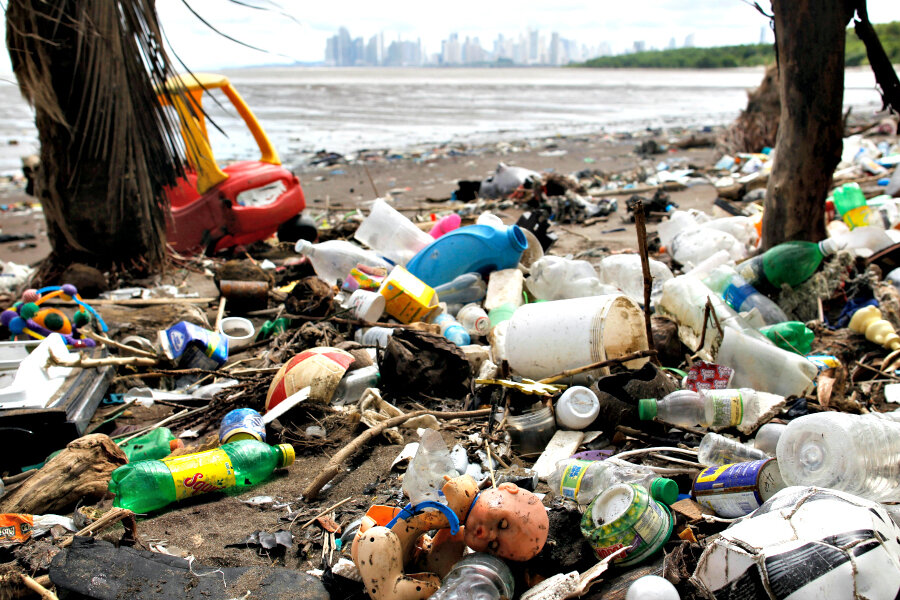Some Adidas products to be made of plastic debris from oceans
Loading...
Can sportswear help save marine life? Leaders of the German athletic wear giant Adidas believe it can, but some scientists are skeptical.
On Monday [April 20], Adidas announced it would start collecting plastic marine debris and recycling the garbage back into products consumers can wear. However modestly, Adidas customers could soon help to address the ocean’s growing pollution problem.
The company partnered with New York–based Parley for the Oceans, an initiative that calls itself a place “where creators, thinkers, and leaders come together to raise awareness for the beauty and fragility of our oceans.”
Starting in 2016, Adidas and Parley will be using new fibers from recycled ocean plastic in clothing products and possibly parts of shoes. It’s a familiar role for Parley, which teamed with musician and entrepreneur Pharrell Williams last year to develop a line of denim clothing created out of fibers from plastic sea garbage.
So how much garbage will the project remove?
“We do have extremely ambitious objectives,” wrote Parley founder Cyrill Gutsch in an email. “But realistically we will retrieve around 10,000 tons of plastic this year from shorelines and by retrieving discarded fishing nets, which we do in collaboration with Sea Shepherd Conservation Society.”
They’ve already started collecting plastic in China, Australia, Hawaii, and the East and West Coasts of the United States. Collection will begin soon in Brazil, Mexico, the Maldives, Greece, France, and the United Kingdom.
Some scientists, however, worry that a portion of the recovered plastic will return to the sea.
Mark Browne, a researcher at the National Center of Ecological Analysis and Synthesis in Santa Barbara, California, says recycled microfibers in apparel can shed in the washing machine, end up in drains, and return to the ocean.
In a 2011 paper, Browne wrote that just one synthetic garment can slough off more than 1,900 fibers per wash. His team tested fresh and marine water sites around the world and found microfibers in every sample. In fact, 85 percent of the human-made material they detected were microfibers.
“If Adidas’ goal is truly to address ocean plastics pollution, this is not a particularly effective tactic—it is challenging to collect plastic without harming ocean life and even more difficult to use these recovered materials to make new products,” said Darby Hoover, senior resource specialist at the National Resources Defense Council. “They should help keep plastic out of the ocean in the first place by promoting recycling and requiring recycled materials be present in all of their products.”
“Are we perfect? No, far from,” Adidas Group CEO Herbert Hainer wrote in the company’s 2014 Sustainability Progress Report. “We face constantly new, industry-wide challenges. But we tackle these challenges and try to improve.”
Even if trying to recycle microfibers isn’t the perfect solution, the need to reduce plastic from the marine environment is unquestionable.
A study published last December in PLOS One said marine plastic totaled at least 268,940 tons, broken down into 5.25 trillion particles—or some 700 pieces for every person on Earth.
A 2012 paper from the World Society for the Protection of Animals estimated that each year, some 57,000 to 135,000 whales are entangled by plastic debris, not to mention perhaps millions of other animals, such as birds, turtles, fish, and other species that ingest or are otherwise affected by the plastic.
Total damages generated by ocean plastic are estimated at $13 billion a year.
The recycling project would also help educate consumers about ocean plastic, even as it removes some of the garbage from the environment.
“A sexy product is the most efficient advertising for a cause,” Parley states on its website. “It is the best proof of concept for a new technology, an innovative material, and gives consumers an easy decision to do the right thing.”
• David Kirby has been a professional journalist for 25 years. His third book, Death at Seaworld, was published in 2012.
• This article originally appeared at TakePart, a leading source of socially relevant news, features, opinion, entertainment, and information – all focused on the issues that shape our lives. Visit takepart.com/start-from-the-source.
Read more about the fight to save the world's oceans in our Blue Planet series.
Related stories on TakePart
This Year, Earth Day Is All About the Oceans
Watch Divers Free Sharks and Other Marine Animals From Deadly 'Ghost Nets'
The Little Fish Foretelling the Future of Ocean Life Harmed by the Deepwater Horizon Disaster







